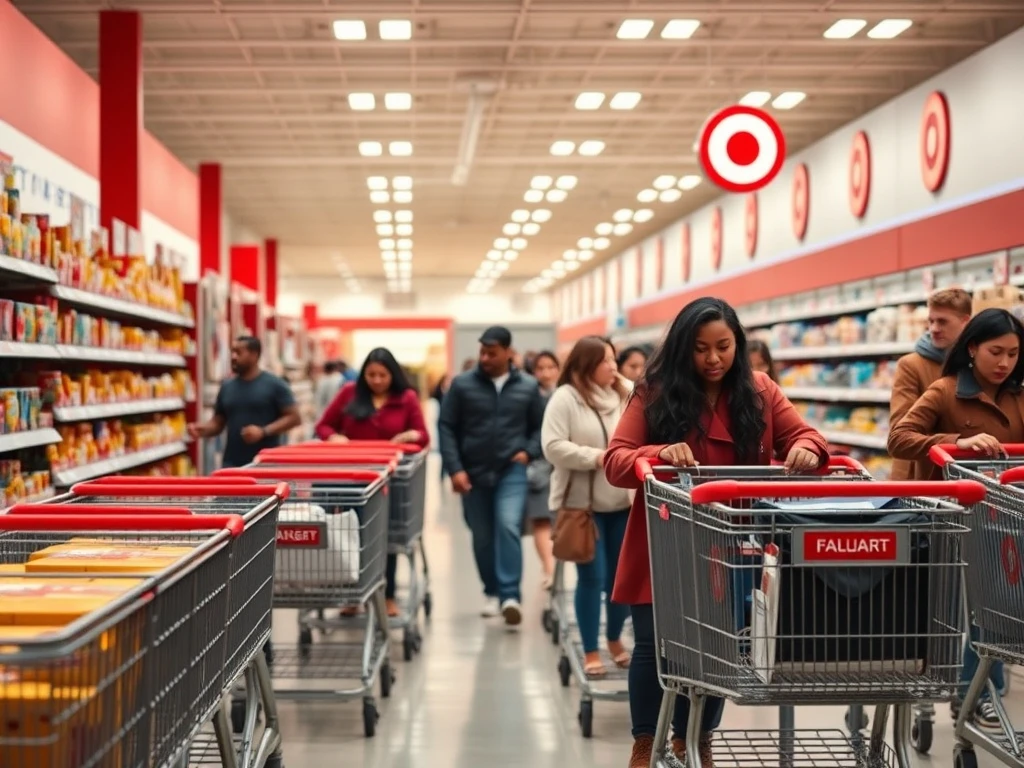In the fiercely competitive retail sector, companies constantly seek innovative ways to attract and retain customers. Target, a prominent player, recently announced significant shifts in its operational approach. This strategic pivot focuses on a bold pricing promise and a notable delivery change. Indeed, these moves aim to redefine customer value and convenience. For business leaders and entrepreneurs, understanding Target’s pricing strategy and its delivery innovations offers crucial insights into modern retail dynamics. This article delves into the specifics of these changes, their potential impact, and what they mean for the broader market.
Understanding Target’s Pricing Strategy Shift
Target has committed to a new pricing philosophy. This bold promise emphasizes consistent value for shoppers. Essentially, the retailer aims to simplify the shopping experience. Customers will find competitive prices on everyday essentials. Moreover, Target plans to maintain these prices over time. This approach reduces the need for constant sales or promotions. Instead, it builds trust through predictable affordability. Historically, many retailers relied heavily on weekly sales. However, this new Target’s pricing strategy signals a shift. It moves towards an ‘everyday low price’ model. This strategy directly challenges competitors. It simplifies budgeting for families. Ultimately, it seeks to make Target a preferred destination for routine purchases.
Several factors underpin this strategic decision. Firstly, consumer behavior has evolved. Shoppers increasingly value transparency. They seek clear, consistent pricing. Secondly, the digital age allows for easy price comparisons. Therefore, a stable pricing structure becomes a competitive advantage. Thirdly, managing complex promotional cycles is costly. Streamlining pricing can improve operational efficiency. This focus on long-term value benefits both the company and its customers. It reinforces Target’s commitment to affordability.
Revolutionizing Delivery: Target’s New Approach
Beyond pricing, Target is also transforming its delivery services. This change aims to enhance convenience significantly. Previously, delivery options varied. Now, Target is streamlining its fulfillment process. This includes faster shipping speeds. Many orders will arrive more quickly. Additionally, the company is expanding its same-day delivery capabilities. Services like Shipt, owned by Target, play a crucial role here. Customers can receive groceries and other items within hours. This focus on speed and reliability directly addresses modern consumer demands. Shoppers expect immediate gratification. They want their purchases delivered promptly. Target’s enhanced delivery system meets this expectation.
The core of this delivery revolution involves several key components:
- Expanded Fulfillment Centers: Target is investing in more localized distribution hubs. These centers allow for quicker processing and dispatch.
- Optimized Last-Mile Delivery: The company is refining its routes and partnerships. This ensures efficient final delivery to homes.
- Enhanced Shipt Integration: Shipt shoppers are now more deeply integrated into Target’s ecosystem. This provides seamless personal shopping and delivery.
These improvements are not just about speed. They also aim for greater accuracy. Fewer errors mean happier customers. The combined effect of improved Target’s pricing strategy and streamlined delivery creates a powerful value proposition. It positions Target as a leader in customer-centric retail.
Why Now? The Drivers Behind Target’s Strategic Moves
Target’s decision to implement these changes is timely. The retail landscape is constantly evolving. Several factors are influencing this evolution. Firstly, intense competition from e-commerce giants and other big-box retailers is a major driver. Companies like Amazon and Walmart consistently push boundaries in pricing and logistics. Target must innovate to maintain its market share. Secondly, consumer expectations have risen. Shoppers now demand both affordability and convenience. They expect seamless online and in-store experiences. Thirdly, inflation has impacted household budgets. Consumers are more conscious of spending. A consistent, transparent Target’s pricing strategy helps alleviate this pressure. It offers predictability in uncertain economic times.
Furthermore, technological advancements play a vital role. Data analytics allows Target to understand customer preferences better. It helps optimize inventory and pricing. Automation in warehouses speeds up order fulfillment. These technologies enable the bold promises Target is making. The company is leveraging its extensive store network too. Stores increasingly function as mini-distribution centers. This hybrid model supports faster local delivery. Ultimately, these strategic shifts reflect a proactive response to market forces. Target aims to strengthen its position for long-term growth. They are adapting to a dynamic retail environment.
Impact on Consumers: What Target’s New Strategy Means for Shoppers
For the everyday shopper, Target’s new strategy brings clear benefits. The bold pricing promise means less guesswork. Customers can trust that prices are competitive. This reduces the mental load of shopping. You will likely spend less time comparing prices. Instead, you can focus on finding what you need. This consistent value fosters loyalty. Shoppers feel confident in their purchases. Moreover, the enhanced delivery options provide unparalleled convenience. Imagine needing groceries for dinner. You can order them in the morning. They arrive within hours. This saves time and effort. It particularly benefits busy families and individuals. The integration of Shipt makes this process smooth. Customers receive personalized service. These changes make shopping at Target more appealing. They address common pain points for consumers. The overall aim is to make Target the go-to choice for a wider range of shopping needs. This customer-centric approach underpins Target’s pricing strategy and delivery enhancements.
Consider the practical advantages:
- Budgeting Made Easier: Predictable pricing helps households manage their finances better.
- Time Savings: Faster delivery and less price hunting free up valuable time.
- Increased Convenience: Shopping fits seamlessly into busy schedules, offering flexibility.
Retail Landscape Shift: Analyzing Target’s Competitive Edge
Target’s bold moves reshape the competitive landscape. This new Target’s pricing strategy puts pressure on rivals. Other retailers may need to re-evaluate their own pricing models. They might adjust their delivery promises. Target is carving out a distinct position. It combines affordability with premium service. This blend is difficult for competitors to replicate. Online-only retailers often lack physical store presence for quick pickups or returns. Traditional brick-and-mortar stores may struggle with delivery speed. Target leverages its omnichannel strength. It integrates its physical stores with its digital capabilities. This creates a powerful synergy. The company can fulfill orders from stores. This speeds up local delivery significantly. It also reduces shipping costs. This integrated approach gives Target a unique edge. It appeals to a broad spectrum of consumers. The market will certainly watch closely. Other companies may follow suit. This could lead to a broader industry trend. The focus will shift towards value and speed. Target is clearly setting a new standard.
Operational Excellence: Supporting Target’s Strategy
Implementing such a comprehensive strategy requires robust operational excellence. Target has invested heavily in its supply chain. This includes advanced inventory management systems. These systems ensure products are always in stock. They also optimize product flow from suppliers to stores. Furthermore, Target is utilizing data analytics more extensively. This helps forecast demand accurately. It allows for proactive adjustments to pricing and stock levels. The company’s technology infrastructure supports these complex operations. It enables seamless integration between online and in-store experiences. Employee training is also critical. Store teams are essential for efficient pick-up and delivery services. They ensure a smooth customer experience. This holistic approach underpins Target’s pricing strategy and delivery enhancements. It ensures the promises made to customers can be consistently met. Without strong operational foundations, even the boldest strategies can falter. Target recognizes this. It continues to refine its internal processes. This commitment to efficiency strengthens its competitive position.
The Future of Retail: Target’s Long-Term Vision
Target’s recent announcements are more than just short-term adjustments. They reflect a long-term vision for the future of retail. The company aims to build lasting customer relationships. It seeks to be the preferred choice for everyday needs. This involves anticipating consumer trends. It means adapting swiftly to market changes. The focus on consistent pricing and rapid delivery is part of this vision. It positions Target for sustainable growth. The retail industry will continue to evolve. Digital transformation will accelerate. Consumer preferences will shift further. By prioritizing value and convenience, Target is building resilience. It creates a loyal customer base. This loyalty is crucial in a volatile market. Target’s pricing strategy, combined with its delivery innovations, sets a precedent. It demonstrates how traditional retailers can thrive. They can compete effectively with online pure-plays. The future of retail lies in seamless, customer-centric experiences. Target is actively shaping that future.
Conclusion
Target’s bold pricing promise and significant delivery changes mark a pivotal moment. These strategic moves are designed to enhance customer value and convenience. They represent a proactive response to evolving consumer demands. By focusing on consistent, competitive pricing, Target aims to build trust. Simultaneously, improved delivery options provide unparalleled speed and flexibility. These initiatives strengthen Target’s position in the highly competitive retail market. They offer valuable lessons for businesses across industries. Ultimately, Target’s pricing strategy and delivery innovations underscore a commitment to customer satisfaction. They set a new standard for excellence in modern retail.
Frequently Asked Questions (FAQs)
What is the core of Target’s new pricing strategy?
Target’s new pricing strategy focuses on offering consistent, competitive everyday prices. It aims to reduce reliance on frequent sales. This provides shoppers with predictable affordability and builds long-term trust.
How is Target changing its delivery services?
Target is enhancing delivery by offering faster shipping speeds and expanding same-day delivery options. This includes better integration with Shipt. These changes aim to provide greater convenience and quicker fulfillment for customers.
Why is Target making these bold changes now?
Target is responding to intense retail competition, evolving consumer expectations for value and convenience, and the impact of inflation on household budgets. These changes help Target maintain its market share and appeal to modern shoppers.
How will Target’s new strategy benefit consumers?
Consumers will benefit from simpler budgeting due to predictable pricing. They will also save time with faster and more convenient delivery options. The overall shopping experience becomes more efficient and reliable.
Does Target’s new strategy affect its physical stores?
Yes, Target’s physical stores play a crucial role. They increasingly function as local fulfillment centers. This allows for quicker same-day and local deliveries, enhancing the overall omnichannel experience for customers.
What is the long-term vision behind Target’s pricing strategy and delivery changes?
The long-term vision is to build lasting customer relationships and ensure sustainable growth. By prioritizing consistent value and convenience, Target aims to remain a preferred retailer, adapting proactively to future retail trends and consumer needs.
























